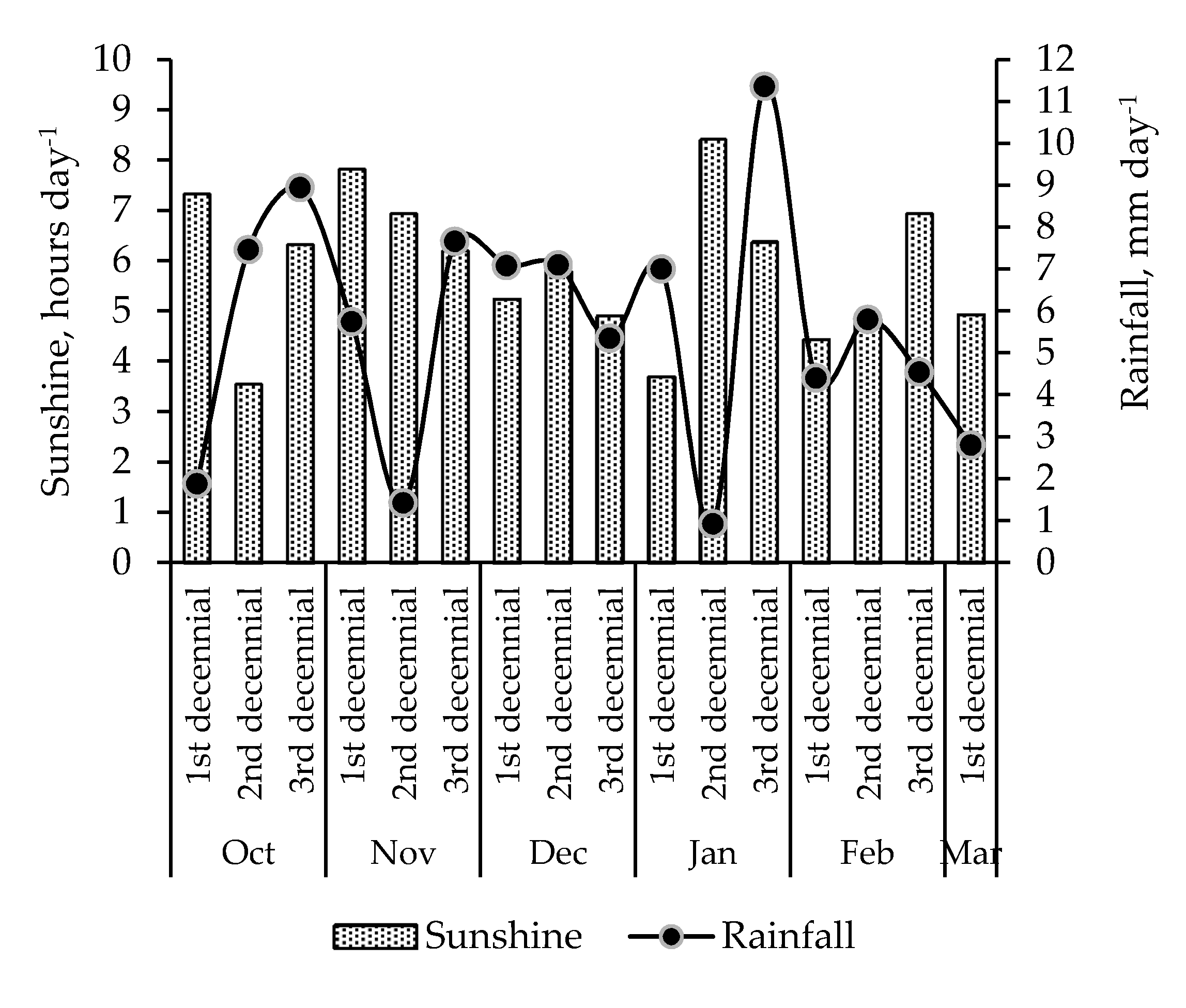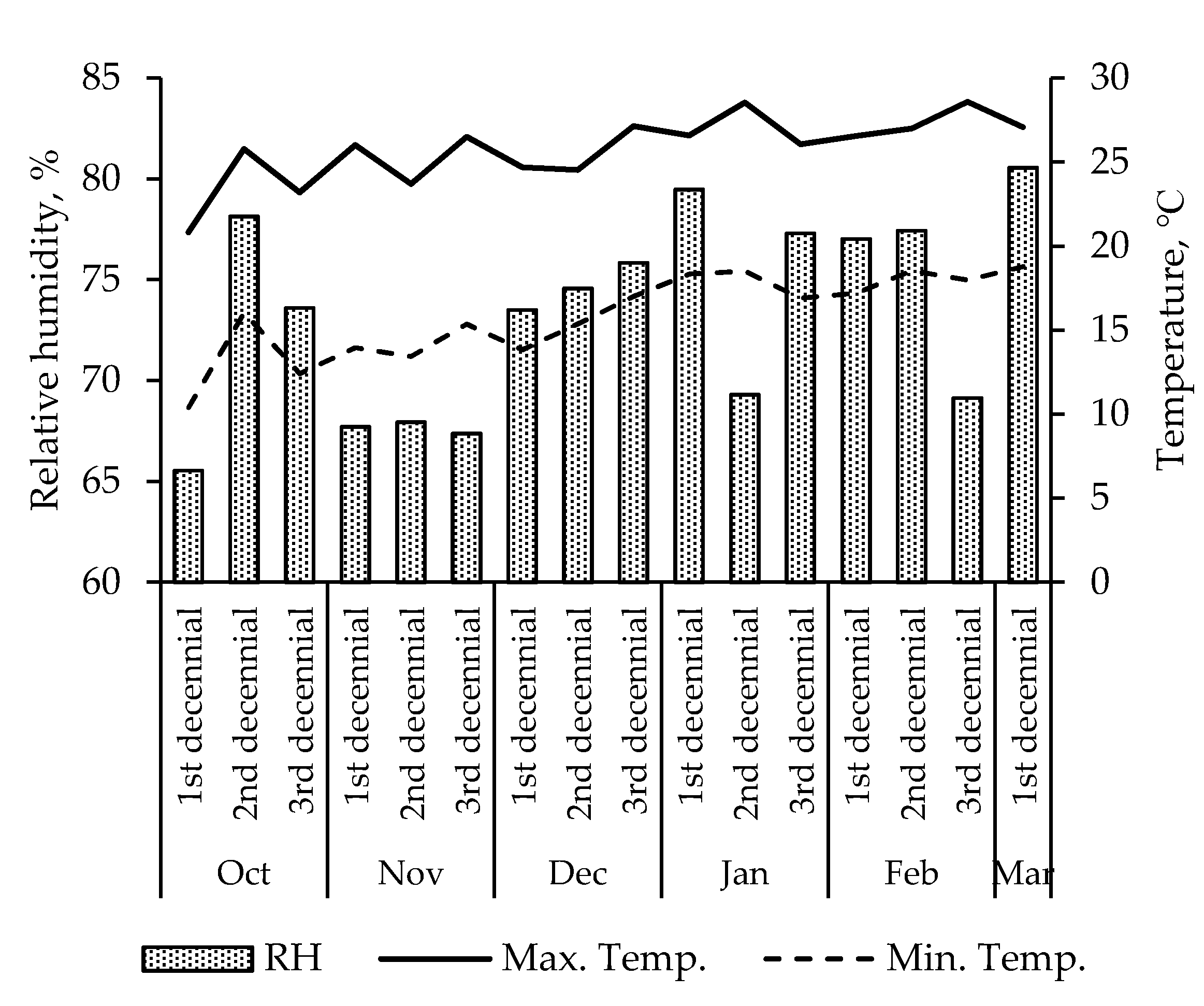4.1. In Vitro Digestibility
The Maximus hybrid is commercially known for having a more pronounced stay-green compared to that of the other hybrids evaluated herein. Thus, it could be expected that the vegetative fraction of this hybrid could be more digestible than that of the other hybrids. Although this difference in favor of the Maximus hybrid was not always observed when IVDMD was determined; other results such as fermentation kinetics or the production of gas or VFA by fermentation, seem to confirm the superiority of the Maximus over the other two hybrids evaluated. In a review, Khan et al. [
1] suggested that a correlation between the stay-green and digestibility of vegetative fractions of plants was not always observed, but stressed the importance of the maturity stage and the DM obtained.
In general, the decrease in the digestibility of the vegetative fractions with increasing maturity was related to the accumulation of cell wall components in leaves and stems and to the accrual of nonstructural carbohydrates to the grains [
3]. Therefore, the general relationship between the optimal stage of maturity and the contribution of each fraction to the whole-plant and its particular digestibility must be observed. As an example, Zeoula et al. [
22] concluded that hybrids with highly digestible stems can reduce concentrate use by up to 1.5 kg per animal day
−1.
The decrease observed in grain digestibility in the Maximus hybrid was also expected in the other hybrids because increasing maturity increases the grain hardness (vitreousness) due to protein matrix accumulation around the endosperm, making it difficult for microorganisms to attack starch granules. [
23]. Due to their increasing proportion in the plant, the grains have a critical contribution to the quality of the whole-plant and therefore, even with observed differences between hybrids and maturity stages for all fractions except for that of grains, the digestibility of the whole-plant was unchanged. However, it should be noted that the digestibility of the whole-plant is primarily dependent on the quality of each fraction and secondarily on their proportions [
3].
Contrary to what was observed after 48 h of incubation, when the in vitro digestibility was determined at shorter incubation times in rumen fluid (16 h for the grain and 24 h of the whole-plant, according to their expected residence times in the rumen), the differences between hybrids and maturity stages were more remarkable. It is worth mentioning that the methodology of Goering & Van Soest [
8] provided grain digestibility values numerically higher than those found by the Tilley & Terry [
9] technique, while the opposite was observed for whole-plants. Holden [
10] highlighted a 5.3% difference in grain digestibility between these methodologies, with that of Tilley & Terry being superior to that of Goering & Van Soest [
8], but no significant difference was observed. Based on these data, Holden [
10] proposed changes in the first technique, which have been currently adopted. Through the technique proposed by Goering & Van Soest [
8], regardless of hybrid, grain digestibility decreased with increasing grain maturity. With the method proposed by Tilley & Terry [
9], the grain of the Defender hybrid exhibited the highest digestibility at R4, which can be explained by being the stage with fastest grain starch accumulation, in comparison with R3 and R5 stages. The digestibility of the whole-plant after 24 h of incubation increased with increasing maturity and seemed to be related to the proportion of grains in the plant. The data presented by Peyrat et al. [
24] demonstrated that starch digestibility does not exhibit statistical differences between maturity stages although the concentration of starch in the plant changes significantly with growth. Di Marco et al. [
4] reported similar results up to the stage preceding the kernel black layer formation, when the highest concentration of starch but low-quality fiber were observed in the plant. Our data corroborate the review by Khan et al. [
1], showing that the advance of the harvest stage provides better DM digestibility, suggesting silage production that can potentially support a higher milk yield by the dairy cow. It should be noted that the digestibility of the whole-plant is determined by both the quality of the vegetative fraction and the increasing proportion of the most digestible fraction (i.e., the grain), as demonstrated in a number of studies [
1,
2,
23].
In situ degradation kinetics of silage from the three hybrids were assessed at stage R5, because at this stage silages were produced with suitable DM intake and acceptable contents of starch and digestible fiber [
21]. Krämer-Schmid et al. [
25] highlighted the importance of the potential degradation of NDF and of the starch concentration on DM degradability to explain the differences found among various maize hybrids. The process of silage fermentation promotes partial hydrolysis of the matrix proteins in the endosperm [
26], favoring faster starch degradation. Thus, hybrids with more starch in the whole-plant at harvest provide silages with a greater soluble or instantly degradable DM, and would explain the increased DM degradability at fast passage rates of hybrids (e.g., Maximus), showing a higher “a” fraction. However, differences were not observed in the degradability of DM at a slow passage rate, where the potential fiber degradation would be more influential.
4.2. Ruminal Fermentation
Fermentation kinetics data, when performed by the in vitro gas production technique, are very valuable, in addition to allowing for the evaluation and screening of a large number of samples with low cost and high repeatability. These data usually show that the evaluation of hybrids and maturity stages is well correlated with the chemical composition [
5]. With a more advanced plant maturity, there is an increase in the DM content and the proportion of grain in the harvested biomass. Corn grain vitreousness is increased with maturity and, consequently, starch utilization may be reduced, limiting the amount of substrate available for fermentation and gas production [
27]. However, the proportion of grain in total DM is also increased, with a reduction of the proportion of more fibrous parts in the whole-plant. Grain provides more a fermentable substrate for gas production when compared to the vegetative fraction, explaining the inverse pattern observed between the production of gas from grains or from the maize whole-plant with increasing maturity. Although the classification of grain maturity stage of maize based on its hardness is important, differences may exist even within a particular stage. According to Pôssas et al. [
27], each hybrid advances in protein matrix deposition at a different rate, justifying the differences in the fermentation kinetics observed among the evaluated hybrids. For example, with the Feroz hybrid, the asymptotic gas production did not differ among stages, whereas with the Maximus and Defender hybrids, the highest and lowest values of this parameter were observed at R3 and R5, respectively. Likewise,
G24 with grain decreased with maturity for the Maximus and Defender hybrids, but there were no difference among stages with the Feroz hybrid. Assuming that the organic matter fermented in the rumen is mostly composed of carbohydrates as proposed by Wolin [
28], it can be expected that ensiling material with more grain, and thus most likely with more starchy carbohydrates, would provide more fermentable matter in the rumen, thus resulting in more gas production. The whole-plant of the Maximus hybrid had a greater proportion of grain (unpublished data) and is characterized by a more pronounced stay-green than the other two hybrids. Therefore, it could be expected that the whole-plant of this hybrid would be degraded in the rumen to a greater extent, and more
G24 volumes were recorded with Maximus than with the other hybrids at the three maturity stages. The gas production technique has been more sensitive than gravimetric in vitro digestibility techniques to discriminate the maize hybrids according to the extent of their degradation in the rumen.
The observed CH
4 production when grain is fermented showed that with maturity, starch degradability may be reduced, thereby reducing CH
4 output at later stages of maturity, although no differences among hybrids in CH
4 production were observed. Increasing starch content in ruminant diets is mentioned by some authors [
29] as an effective way to decrease CH
4 emission per unit of fermented matter. In our study, methane was increased at later stages of maturity in Maximus and Defender hybrids, most likely due to the increased grain proportion to the biomass, so that more organic matter is readily fermentable regardless of the likely reduction in fiber NDF degradation [
30,
31]. Hatew et al. [
31] suggested that advancing maize plant maturity decreases CH
4 emissions in dairy cows mainly by reducing the ruminal fractional rate of starch degradation, causing an increased escape of starch to the duodenum. However, in in vitro batch cultures, starch cannot escape fermentation and is fully available for microbial digestion; thus, methane production is cumulative [
30]. Differences between in vitro and ruminal data are continuously described [
7] but do not invalidate the method to investigate the differences between feeds.
Advancing plant maturity tends to reduce NDF content and increase starch content, determining the VFA production profile, namely, increasing propionate and decreasing acetate production [
31]. The increase in grain concentration in the plant induces a reduction in rumen liquid pH and generally favors propionate production at the expense of acetate [
7,
32]. Structural carbohydrates are the main source for acetate and butyrate production from rumen fermentation, and their synthesis results in an increase in H
2 production, which is used together with CO
2 by methanogenic microorganisms for CH
4 production [
7]. An increased fiber content in the plant (often caused by the advancement of the maturity stage) not only increases CH
4 production but also increases the molar proportions of butyrate and acetate. The total VFA production was different between maturity stages for the evaluated hybrids, showing that comparisons of harvest stages with only one hybrid utilized for silage production should be interpreted with caution. Valerate and iso-acids originated from protein fermentation, with the amino acid proline (present in large quantities in prolamins) as one of the main sources [
33]. Changes in protein degradation are related to differences in ammonia concentration in batch cultures. However, it was not possible to observe noticeable differences among hybrids or maturity stages in these parameters.
4.3. Energy and Estimated Milk Yield
One of the main differences among hybrids when estimating their energy value is starch [
34]. The starch content of the whole-plant was analyzed with an enzymatic kit, and data were entered into the Milk2006 model [
19,
20]. The different hybrids showed more or less energy value at different maturity stages, which also affected the estimation of milk yield per ton of DM harvested. Our data would suggest a higher grain yield for the Feroz than for the other hybrids at stage R3, but a higher grain yield for the Maximus hybrid at stage R5, and both exhibited higher energy values at the corresponding stages. Slight variations in fiber digestibility may not be sufficient to influence the estimation of milk yield potential [
35], whereas the gradual increase in the proportion of grains in the plant with increasing maturity showed its importance. As the grain is the most energetic fraction, the most advanced stages showed the highest values for both net energy content and potential milk yield, even with a tendency for fiber utilization to be decreased. According to Johnson et al. [
36], the highest nutritional value of most maize hybrids is attained when plants have between 33 and 36% DM. This occurred at the R4 and R5 stages for the hybrids evaluated in this study. Finally, the yield of each hybrid should be taken into account for decision making, as the differences found in DM yield per area were balanced by the differences observed between hybrids when estimating the milk yield per hectare.









